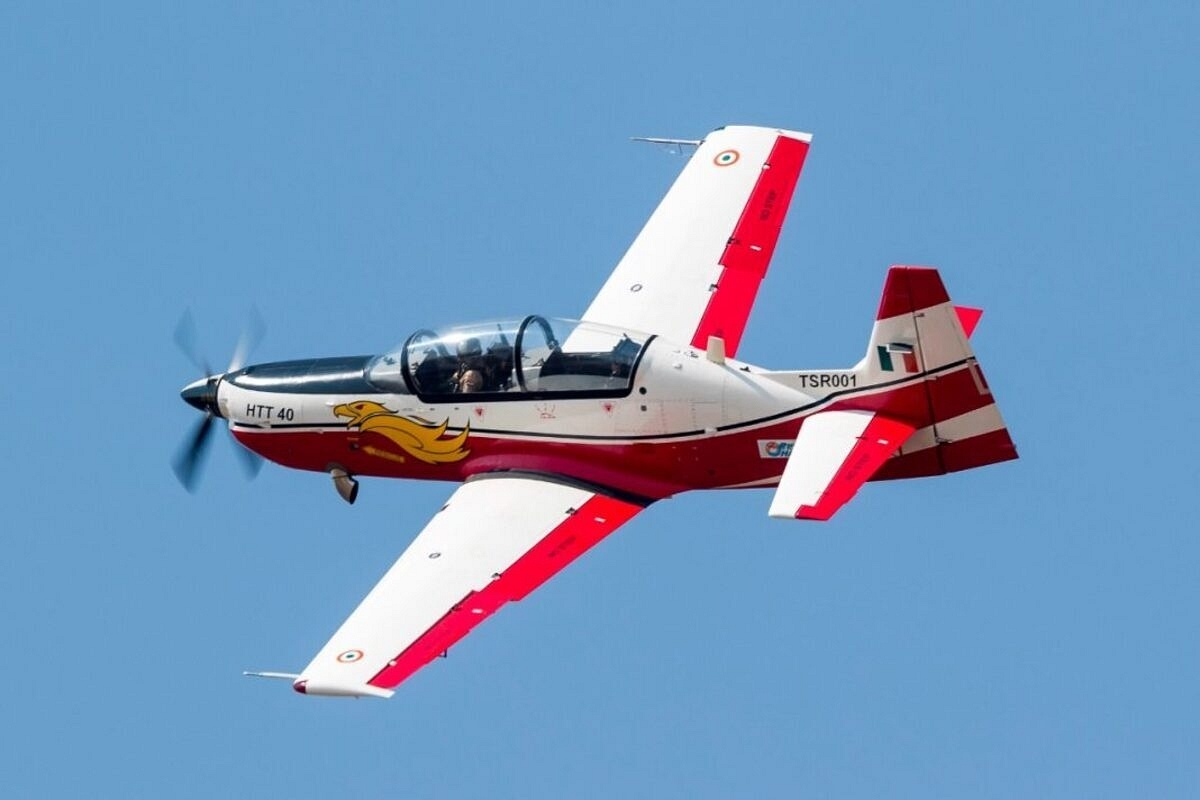Defence
Concerns Mount Over HTT-40 Trainer Aircraft Delivery Timeline Amid Delayed Airworthiness Certification: Report

HAL's HTT-40 (Twitter)
Six months after the Indian Air Force (IAF) inked a contract with the Hindustan Aeronautics Limited (HAL) for 70 HTT-40 basic trainer aircraft, concerns are mounting over a potential delay in the planned delivery schedule.
The delay stems from the fact that the indigenously manufactured aircraft is still awaiting full airworthiness certification from the Centre for Military Airworthiness and Certification (CEMILAC).
According to a report by the Indian Express (IE), the CEMILAC had granted provisional airworthiness compliance to the HTT-40 with several 'critical limitations'.
However, the aircraft must secure a complete airworthiness certificate before production can commence — a process currently in progress by HAL.
CEMILAC, operating under the purview of the Defence Research and Development Organisation (DRDO), is responsible for providing airworthiness certification for all military aircraft, helicopters, Unmanned Aerial Systems (UAS), aero-engines, and other air-launched weapons, thereby ensuring flight safety.
Earlier In March this year, the Ministry of Defence sealed a Rs 6,800 crore contract with HAL for the procurement of 70 HTT-40s, intended to address a crucial shortfall in pilot training aircraft availability.
Sources within HAL reported that the HTT-40 has already been certified against FAR 23 (Federal Aviation Regulation).
"The aircraft is yet to be certified against the ASQR (Air Staff Quality Requirements) issued by IAF. The draft 'Release to Service Document' is submitted to RCMA (Regional Centre of Military Airworthiness.) This is expected to be cleared by October 2023," the Indian Express report quoting a source in HAL stated.
The source clarified that the HTT-40 remains on schedule, noting that significant jigs and fixtures have been ordered by HAL, and materials procurement activities are underway.
"All the aircraft will be supplied over a period of six years, say by 2029, though we cannot put the exact time frame for the first and the last deliveries," the source added.
The substantial gap in the availability of adequate trainer aircraft for IAF pilots became apparent following the grounding of the HAL-made trainer aircraft HPT-32 around 2010.
As a temporary solution, the IAF procured 75 Pilatus PC-7 Mk II planes from Switzerland under a contract signed in 2012 to address the critical shortage in pilot training.
Additionally, in the absence of an indigenous basic trainer aircraft at the time, the IAF had the option of placing a follow-on order for another 38 aircraft, a requirement approved by the Defence Acquisition Council.
A government statement had previously indicated that the induction of the aircraft was slated to commence in September 2025 and continue until March 15, 2030.
The procurement plan also encompassed a Full Mission Simulator for the aircraft to augment aerial training, enabling pilots to practice various profiles on the ground before engaging in sorties.
However, with the final certification still pending, apprehensions have surfaced regarding the HTT-40's ability to meet the promised delivery schedule.
One official knowledgeable about the matter stated that the delay in acquiring an indigenous basic trainer aircraft contributed to the pilot shortage in the IAF.
"The IAF opted to procure the aircraft to support the indigenous project even before it was certified and met many performance parameters in training," the official remarked.
Furthermore, officials underscored the importance of obtaining the final certification, emphasizing that the HTT-40 will be flown solo by novice pilots, necessitating an aircraft that is 'forgiving' and possessing a 'very high degree of safety'.
Manufactured by HAL and designed and developed indigenously by its Aircraft Research & Design Centre, the HTT-40 is equipped with a four-bladed turbo-prop engine.
HAL reports that the aircraft will feature a state-of-the-art glass cockpit, modern avionics, and the latest safety features, including a zero-zero ejection seat.
It boasts a maximum speed of 450 kilometers per hour and a maximum service ceiling of six kilometers.
Support Swarajya's 50 Ground Reports Project & Sponsor A Story
Every general election Swarajya does a 50 ground reports project.
Aimed only at serious readers and those who appreciate the nuances of political undercurrents, the project provides a sense of India's electoral landscape. As you know, these reports are produced after considerable investment of travel, time and effort on the ground.
This time too we've kicked off the project in style and have covered over 30 constituencies already. If you're someone who appreciates such work and have enjoyed our coverage please consider sponsoring a ground report for just Rs 2999 to Rs 19,999 - it goes a long way in helping us produce more quality reportage.
You can also back this project by becoming a subscriber for as little as Rs 999 - so do click on this links and choose a plan that suits you and back us.
Click below to contribute.
Latest